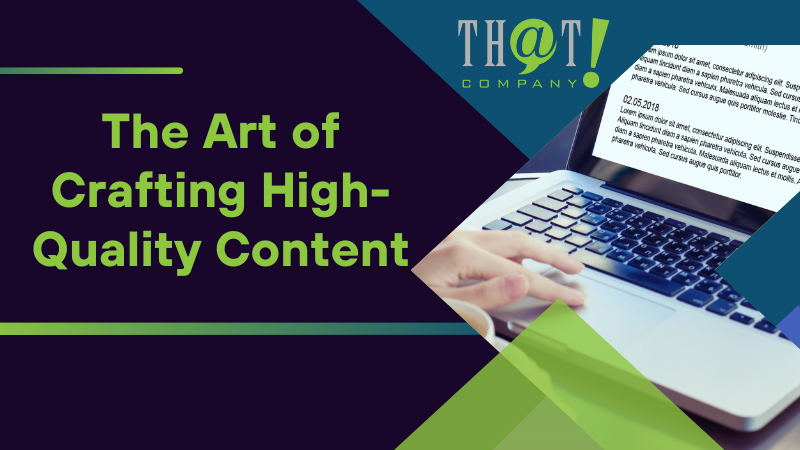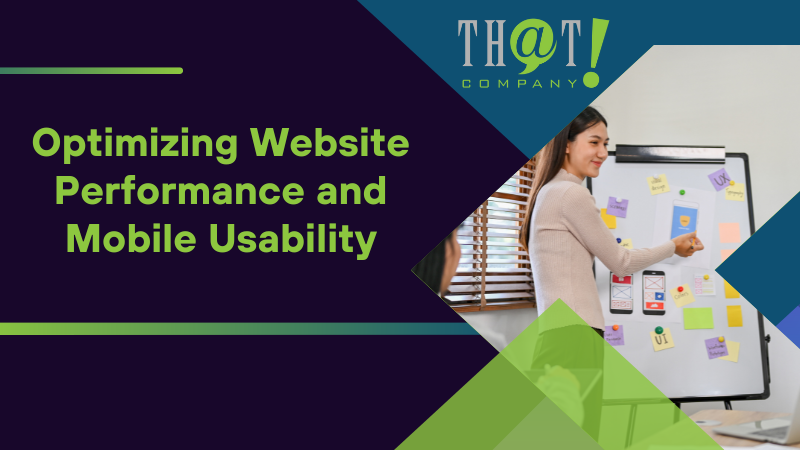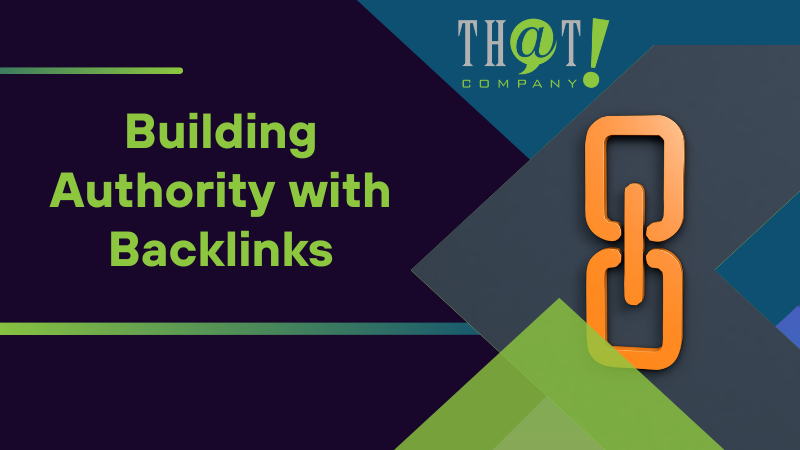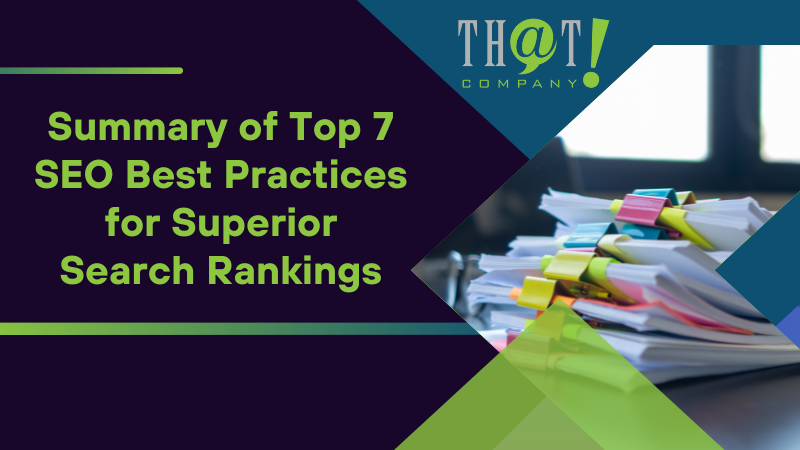
Are you striving to improve your website’s SEO but not sure where to start? Effective SEO best practices are the cornerstone for increasing visibility and driving organic traffic to your site. In this article, we’ve distilled the essential strategies you’ll need to climb the search rankings—a no-nonsense, step-by-step guide for practical SEO improvement.
Key Takeaways
- That! Company provides white label SEO services with a flat fee pricing model, enabling agency partners to handle a larger client load while offering tailored digital marketing services to improve sales and client satisfaction.
- Effective keyword strategies involve using various research tools for opportunity identification, strategic keyword placement in content, and understanding the role of long-tail keywords for attracting qualified traffic and improving SEO.
- High-quality, engaging content enhanced with multimedia elements, good on-page optimization, strategic internal linking, optimized website performance and mobile usability, authority-building backlinks, and leveraging local SEO are key practices for superior search rankings.

That! Company the SEO Agency that Other SEO Agencies Use
With a proven track record of enhancing sales performance, That! Company stands out as a leading provider of digital marketing white label services. From report creation to client meetings, That! Company takes over time-consuming tasks, freeing up the time of agency partners and enabling them to handle a larger client load. This approach not only boosts sales capabilities but also enhances service offerings through a range of customized digital services including SEO, PPC, and social media.
The company’s unique flat fee pricing model ensures transparent and predictable costs, aiding agencies in better financial planning and sales strategy. By leveraging their extensive experience in digital marketing and using proprietary tools, That! Company delivers high-quality services that improve client satisfaction and retention, thereby boosting sales for partners. All these factors have cemented That! Company’s reputation as the SEO agency that other agencies use. Moreover, utilizing white label SEO providers can significantly enhance your online visibility and maximize your reach.

Unlocking the Power of Keywords for SEO
Keywords are the backbone of any successful SEO strategy. Understanding and satisfying search intent is instrumental in determining the relevance and discoverability of content on search engine results pages. To align content with what users are actively searching for, it’s essential to step into the mindset of potential customers and consider niche-focused relevant keywords.
An effective SEO strategy also employs a balanced approach in keyword specificity, ensuring keywords are neither too broad nor too narrow, and utilizes a variety of related phrases on the same topic for better targeting. But how do you master keyword research tools, place keywords strategically, and understand the role of long-tail keywords? Let’s delve deeper.
Mastering Keyword Research Tools
Keyword research tools like Semrush, Ahrefs, and Google Keyword Planner can be your best allies in developing a successful SEO strategy. These tools offer comprehensive insights into keyword performance, competition, and can help to uncover long-tail keyword opportunities.
By identifying opportunities and understanding search volume trends, you can ensure your SEO strategies are aligned with what users are actively searching for, thereby boosting your website’s search engine ranking.
Strategically Placing Your Keywords
Strategically placing keywords in your content is crucial for SEO. For instance, optimizing header tags with main keywords can increase the probability of securing featured snippets in search results. Also, incorporating main keywords into page titles helps to improve search engine optimization and relevance.
Furthermore, distributing keywords naturally throughout your webpages not only enhances content readability but also provides SEO benefits. Thus, strategically placing your keywords can significantly boost your website’s visibility and search engine ranking.
Understanding the Role of Long Tail Keywords
Long tail keywords play a significant role in SEO. By targeting industry-related and local long tail keywords, you can attract qualified traffic that is more likely to convert, thereby reducing bounce rates and improving search engine rankings. Moreover, utilizing keyword modifiers in conjunction with local keywords can help attract highly targeted local traffic.
Hence, understanding the role of long tail keywords can significantly enhance your SEO strategy and website performance.

The Art of Crafting High-Quality Content
High-quality content is the cornerstone of any successful SEO strategy. By creating content that shares new insights, solves tough problems, and challenges common misconceptions, you can achieve higher rankings on Google. However, it’s crucial to prioritize the audience’s specific needs and questions over merely optimizing content for search engines to ensure genuine value and user engagement.
Moreover, leveraging diverse content forms such as:
- blog posts
- videos
- infographics
- social media updates
can increase visibility and user interaction. Now, let’s delve into how to balance information with engagement and enhance content with multimedia elements.
Balancing Information with Engagement
Providing information while keeping users engaged is an art. By breaking up text into scannable sections using header tags, you can significantly enhance the readability of your content. Google rewards content with enhanced user experience, which can be achieved through effectively using header tags to create scannable content.
Moreover, making header tags interesting and engaging can lead visitors to spend more time on the page, thereby increasing engagement.
Enhancing Content with Multimedia Elements
Multimedia elements play a critical role in enriching website content. By incorporating relevant high-quality images and videos, you can:
- Make your content more appealing
- Significantly enhance the user experience
- Improve search engine rankings, making your website more visible to potential customers.

On-Page Optimization Techniques
On-page optimization techniques, including on page seo, are crucial for improving search rankings and user experience. They include optimizing title tags, meta descriptions, and header tags. But how does one create unique meta descriptions for each page and write effective title tags? Let’s explore.
Creating Unique Meta Descriptions for Each Page
Meta descriptions are HTML tags that summarize a page’s content for users in search results. Although they don’t directly affect SEO, well-crafted meta descriptions can influence click-through rates, indirectly benefiting your SEO efforts.
To craft an effective meta description, ensure it’s unique, accurate, and includes the target keyword. This way, you can make your pages more appealing to users and search engines alike.
Writing Effective Title Tags
Title tags are a critical factor in improving click-through rates from search results. An effective title tag should be clear and concise to immediately tell users what the page content is about. Including the primary keyword in the title tag also helps with search engine optimization and improves the relevance of the page for users.
Thus, mastering the art of writing effective title tags can significantly enhance your SEO efforts.

Internal Linking: A Keystone of SEO Strategy
Internal linking plays a critical role in SEO. It helps search engines understand a website’s structure, enhances crawling efficiency, improves user experience, and funnels users towards conversion points by utilizing internal links.
But how does one map out a strategic internal linking structure and avoid common internal linking mistakes? Let’s delve into these topics.
Mapping Out a Strategic Internal Linking Structure
A strategic internal linking structure aligns with user journey stages and content relevancy. Regularly revising the internal linking strategy is essential to avoid common linking errors and enhance linking purposefulness.
By strategically mapping the internal linking structure, you can significantly enhance site architecture and enrich user experience.
Avoiding Common Internal Linking Mistakes
Avoiding common internal linking mistakes is crucial for maintaining your website’s SEO ranking and performance. Regular backlink audits using tools like Moz and Google Search Console are essential to assess and elevate the quality of your website’s backlink profile.
By avoiding toxic links from spammy or low-quality domains and updating or removing broken links, you can safeguard your website’s SEO ranking.

Optimizing Website Performance and Mobile Usability
Optimizing website performance and mobile usability is crucial for improving user experience and search rankings. Some common issues that can affect website load time include:
- Code density
- Heavy images
- JavaScript problems
- Mediocre hosting
Addressing these issues through methods like code optimization and image compression, following best practices, can enhance website performance and user experience.
But how does one improve site load times and ensure a mobile-friendly design? Let’s explore.
Improving Site Load Times for Better User Experience
Improving site load times is crucial for enhancing user experience. By addressing issues such as code optimization, image compression, and improving hosting solutions, you can significantly enhance site performance and user experience.
Switching from shared to dedicated hosting can also greatly improve site speed, avoiding performance problems often associated with shared resources.
Ensuring Mobile-Friendly Design
Ensuring mobile-friendly design is crucial in today’s digital age. With over 54% of global website traffic generated from mobile devices, having a mobile-friendly website is no longer an option but a necessity. Optimizing for mobile users can lead to:
- Higher levels of engagement
- Higher conversion rates
- Improved user experience
- Better search engine rankings
It is essential for maintaining compatibility with search engine requirements.

Building Authority with Backlinks
Backlinks are essential for SEO as they help build domain authority and improve rankings on targeted keywords. Creating high-quality content is a strategy to establish backlinks naturally, as this content is more likely to be referenced by other websites, enhancing your site’s visibility and importance to search engines.
But how does one identify opportunities for quality backlinks and manage their backlink profile? Let’s delve deeper.
Identifying Opportunities for Quality Backlinks
Identifying opportunities for quality backlinks is crucial for improving your website’s SEO ranking. Tools like HARO connect content creators with journalists who need expert quotes, offering opportunities to secure backlinks from reputable sources.
Ensuring the sources are authoritative and trustworthy, and the content is relevant, can help you secure quality backlinks.
Monitoring and Managing Your Backlink Profile
Monitoring and managing your backlink profile is crucial for maintaining your website’s SEO ranking and performance. Tools like LinkChecker PRO, SEMRUSH, and Google Search Console can help track backlink health and provide notifications of any changes or issues.
Regular backlink audits using tools like Moz and Google Search Console are essential to assess and elevate the quality of your website’s backlink profile.

Leveraging Local SEO for Targeted Impact
Leveraging local SEO services can help businesses target customers based on geographic locations. A well-optimized Google My Business profile can significantly enhance visibility in Google search results, especially for local search results.
But how does one claim and optimize Google My Business listings and incorporate local keywords and content? Let’s delve into these topics.
Claiming and Optimizing Google My Business Listing
Claiming and optimizing Google My Business listings is crucial for local SEO. A complete Google My Business profile, including accurate business information, can increase the likelihood of appearing in Google’s local 3-pack and other local search results. Verifying your Google My Business listing is also necessary for authentication.
Incorporating Local Keywords and Content
Incorporating local keywords and content can significantly enhance your local SEO efforts. Location-based keywords are pivotal for an SEO strategy focused on targeting customers based on geographic locations.
Using location-specific target keywords helps target potential customers who are searching for services or products in specific areas, even if they are not presently in the same location.

Summary
To maximize your website’s reach and climb the search rankings, it is essential to implement SEO best practices effectively. This comprehensive guide has covered the pivotal strategies, from utilizing white label SEO services like That! Company to mastering keyword research tools and strategically placing keywords. We’ve explored the importance of crafting high-quality, engaging content and the necessity of on-page optimization techniques. Internal linking was emphasized as a keystone of SEO strategy, while optimizing website performance and mobile usability were highlighted as crucial for user experience. Building authority with backlinks and leveraging local SEO were also discussed as key practices for targeted impact.
By following the detailed steps outlined in each section, you can enhance your website’s visibility, drive organic traffic, and ultimately improve sales and client satisfaction. Remember, SEO is an ongoing process that requires constant attention and adaptation to the ever-evolving digital landscape. So keep refining your strategies, stay updated with the latest trends, and watch your website rise to the top of search rankings.
Let your digital presence be as vast as the ocean, where every drop of effort counts towards a wave of success.

Frequently Asked Questions
What are best practices in SEO?
The best practices in SEO include adding your main keyword early in your content, writing unique titles and descriptions, optimizing your title tag, improving your site’s user experience, and optimizing your site’s loading speed. It is also important to align your content with search intent, leverage primary keywords, write compelling title tags and meta descriptions, optimize your images, build an internal linking structure, and improve user experience.
What are 3 main areas of SEO?
The three main areas of SEO are on-page SEO, off-page SEO, and technical SEO, each focusing on different aspects of optimization to improve search engine rankings.
What are the 5 important concepts of SEO?
Keywords, on-page optimization, off-page optimization, content, and user experience are the 5 important concepts of SEO. Mastering these aspects can significantly improve your website’s search engine ranking.






























